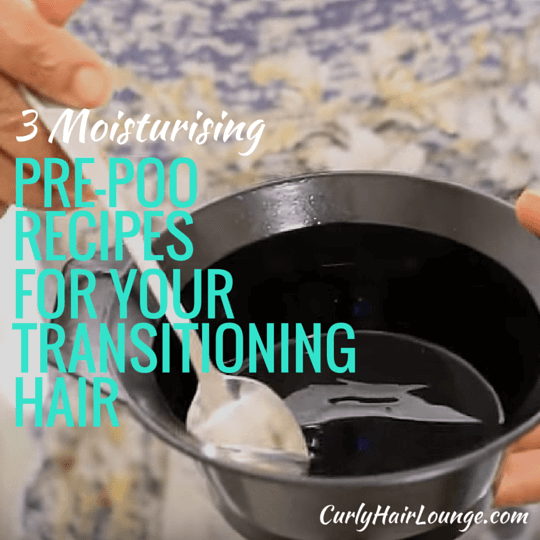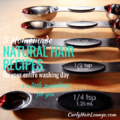Whether you like it or dismiss it, find it absolutely necessary or a waste of time the truth is a pre-poo can make a really big different to the health of your transitioning hair. Yes, it’s perfectly possible to have healthy hair without subscribing to it, but your hair would be a lot more resilient if you did a pre-poo on your wash day. Having transitioning hair equates to having fragile hair that can easily break at the line of demarcation if real attention is not put into its care. So why not provide the first line of defense to your weak hair with one of these moisturising pre-poo recipes?
If you landed on my blog for the first and you’re thinking what the heck is a pre-poo?! Don’t fret my friend, it’s nothing complicated. It’s actually very simple. A pre-poo is a treatment you do to your hair before you shampoo it to protect it from the drying effects a cleansing session can have on natural hair. Get it?! Pre-poo is short for pre-shampoo, you can do it in many different ways and none is expensive, I can bet you have most of the ingredients in your house already.
I could give you a lot more information about it, but I am not going to bore the life of those who already know what a pre-poo is. But, I’m also not gonna leave you hanging if you’re in the dark about this. If you’d like more detailed information about it you can read Should You Pre-Poo Your Hair? hopefully, it will answer all you questions. If it doesn’t drop me a comment and so I can help you, right?! OK, now, shall we move on and head straight to the recipes?
PRE-POO RECIPES
Coconut & Honey Pre-poo
3 Tbsp. Extra Virgin Coconut Oil
2 to 3 Tbsp. Honey
Place the coconut oil and honey in a container and blend until it becomes a homogenous mixture. Lightly dampen your hair with a water spray bottle (this will help with the honey’s stickiness), but be careful not to over do it you just need a little bit of moisture so your hair is not completely dry. Next, section your hair into four or more section to guarantee maximum coverage and work your pre-poo treatment on your tresses. Cover with a plastic cap and leave it on for a minimum of 30 minutes, then rinse and wash your hair as usual.
The benefit of having coconut oil here is that this vegetable oil is known for, and is scientifically proven, to protect your hair from protein loss, which happens just by washing or manipulating your hair, and can also help your hair if you have hygral fatigue. Honey in this recipe works as a humectant, attracting and retaining moisture in your hair.
Conditioner, Coconut Oil and Castor Oil
3 -2 Tbsp. Conditioner
2 Tbsp. Extra Virgin Coconut Oil
1 Tbsp. Castor Oil
Blend castor oil, coconut oil and a regular conditioner in a container and set aside. Moisten your hair with a water spray bottle or sprinkle water with your hands. Stroke your hair to let it absorb the water and make as many sections as you like. Apply your pre-poo creme making sure not to miss any curls. Make twists or braids or simply hold your hair with a hair clamp, cover with a plastic cap or bag and leave it on for no less than 30 minutes.
In this recipe, the conditioner will make it easier for you to spread the pre-poo more easily and will also provide slip to help detangle, if you want to do it at this stage. As its first ingredient is water, you’ll be hydrating your hair and the coconut oil will help to keep it in and work its own magic once in there. The castor oil is a thick oil known for its ability to help grow your hair, thicken your hair strands, treat dandruff, control (progression) split ends and more. Surely a good reason to add it here, but if this oil is not your cup of tea then replace it by one of your preference, or try avocado oil as it’s full of amino acids and will help strengthen your transitioning hair.
Aloe Vera and Coconut Oil
4 Tbsp. Aloe Vera Gel
3 Tbsp. Extra Virgin Coconut Oil
Combine the aloe vera gel and coconut oil into a uniform mixture and put it aside while you lightly dampen your hair with water and section it for an easier application of the pre-poo. Work the treatment on each section and once finished use a cap or some cling film to cover your hair, let it rest for 30 minutes or more and you can then continue with your washing routine.
The benefits of using aloe vera in any hair treatment are countless, but in case you don’t know making a pre-poo with aloe will help with detangling, soothe your scalp in case you have any condition, it will restore pH levels and it will deeply moisturise your hair because of its abilities as an humectant. These are some of the benefits of using aloe vera just to name a few.
As you can see the recipes and application process are very easy and I hope you’ll give them a try. Adjust the measurements to your hair length, only you know how much product/ingredients your hair “soaks up”. I like to leave my oil pre-poo work overnight, but with these recipes I feel they would slip through the plastic cap and make a mess in my bed, but you are welcome to try (let me know how that goes!). If you want to, you can try detangling as you apply your pre-poo, or you can do it later on while you’re applying your conditioner, it’s your choice.
Finally, I will leave you with 5 Tips To Make Your Oil Pre-Poo More Effective just in case you want to make a simple oil pre-poo.







6 thoughts on “3 Pre-Poo Recipes For Your Transitioning Hair”
Thank you so much! I use both of these! They’re absolutely amazing!
You’re welcome, Alicia!
Monica
Hi! Can I leave the conditioner, coconut oil and castor oil pre poo overnight
Hi Gbemi,
Yes, you can do that, many people do. However, unless your hair is in extreme need (very, very dry), I don’t advise people to do overnight deep conditioning regularly (cause that is basically what that mix is). Maybe once in a while, this is because it can cause hygral fatigue (read more about it here).
Take care! 🙂
Monica
Excited to try the coconut oil and honey mixture! 🙂 Love that I have these ingredients around the house already since we are all quarantined!
Hi Shelby, though my hair routine has changed a lot since the start of my journey and I don’t do them as often an oil pre-poo (not a heavy-handed one) is still something I consider beneficial.